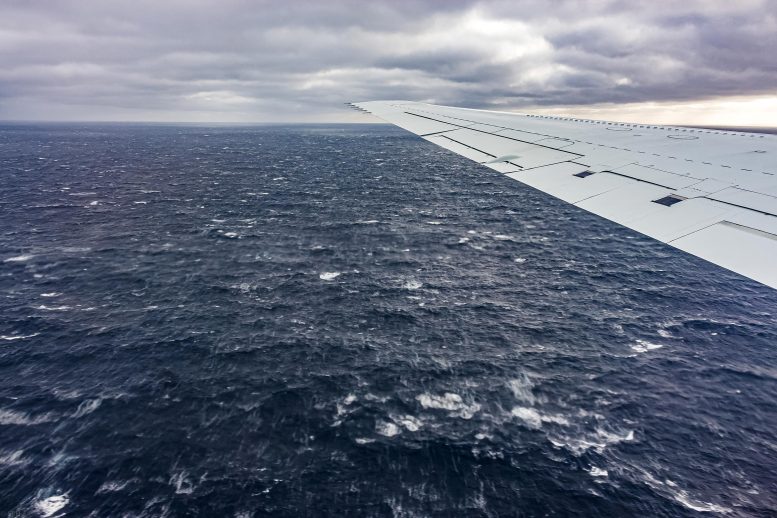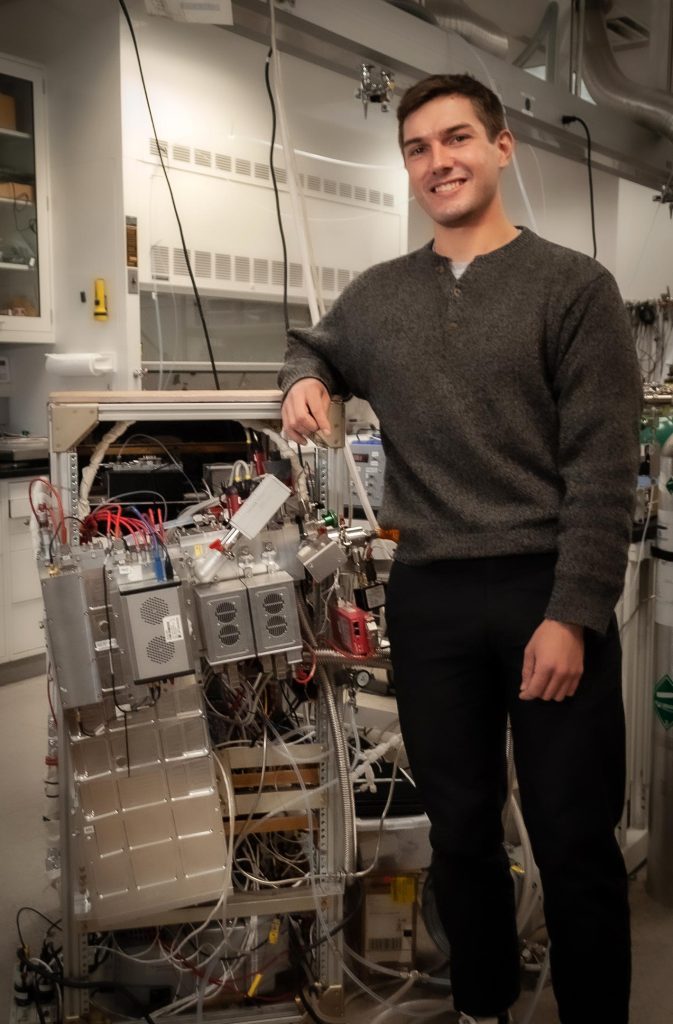
The view from the DC-8 research aircraft as flies through the marine boundary layer, the portion of the atmosphere close to the ocean’s surface where the ocean affects processes like cloud formation. Credit: Sam Hall
Ocean Life Helps Produce Clouds, but Existing Clouds Keep New Ones at Bay
Stand on the ocean’s shore and take a big whiff of the salt spray and you’ll smell the unmistakably pungent scent of the sea. That ripe, almost rotting smell? That’s sulfur.
Marine plankton breathe more than 20 million tons of sulfur into the air every year, mostly in the form of dimethyl sulfide (DMS). In the air, this chemical can transform into sulfuric acid, which helps produce clouds by giving a site for water droplets to form. Over the scale of the world’s oceans, this process affects the entire climate.
But new research from the University of Wisconsin–Madison, the National Oceanic and Atmospheric Administration and others reveals that more than one-third of the DMS emitted from the sea can never help new clouds form because it is lost to the clouds themselves. The new findings significantly alter the prevailing understanding of how marine life influences clouds and may change the way scientists predict how cloud formation responds to changes in the oceans.

First author of the study Gordon Novak pictured with the National Oceanic and Atmospheric Administration chemical-sensing equipment used in the study. Credit: Courtesy of Gordon Novak
By reflecting sunlight back into space and controlling rainfall, clouds play significant roles in the global climate. Accurately predicting them is essential to understanding the effects of climate change.
“It turns out that this story of cloud formation was really incomplete,” says Tim Bertram, a UW–Madison professor of chemistry and senior author of the new report. “Over the last three or four years, we’ve been questioning parts of that story, both through laboratory experiments and with large-scale field experiments. Now we can better connect the dots between what’s emitted from the ocean and how you form these particulates that encourage cloud formation.”
With collaborators from 13 other institutions, Gordon Novak, a graduate student at UW–Madison, constructed the analysis that was published October 11, 2021, in the Proceedings of the National Academy of Sciences.
A few years ago, this group of collaborators, led by Patrick Veres at NOAA, discovered that on its way to becoming sulfuric acid, DMS first turns into a molecule known as HPMTF, which had never been identified before. For the new study, the team used NASA-owned, instrument-laden aircraft to capture detailed measurements of these chemicals over the open ocean both inside of clouds and under sunny skies.
“This is a massive DC-8 aircraft. It’s a flying laboratory. Essentially all of the seats have been removed, and very precise chemical instrumentation has been put in that allows the team to measure, at very low concentrations, both the emitted molecules in the atmosphere and all of the chemical intermediates,” says Bertram.
From the flight data, the team discovered that HPMTF readily dissolves into the water droplets of existing clouds, which permanently removes that sulfur from the cloud nucleation process. In cloud-free areas, more HPMTF survives to become sulfuric acid and help form new clouds.
Led by collaborators from Florida State University, the team accounted for these new measurements in a large, global model of ocean atmospheric chemistry. They discovered that 36% of the sulfur from DMS is lost to clouds in this way. Another 15% of sulfur is lost through other processes, so the upshot is that less than half of the sulfur marine plankton release as DMS can help nucleate clouds.
“This loss of sulfur to the clouds reduces the formation rate of small particles, so it reduces the formation rate of the cloud nuclei themselves. The impact on cloud brightness and other properties will have to be explored in the future,” says Bertram.
Until recently, researchers have largely ignored the effects clouds have on chemical processes over the ocean, in part because it is difficult to obtain good data from the cloud layer. But the new study shows both the power of the right instruments to get that data and the significant roles clouds can play, even influencing the processes that give rise to the clouds themselves.
“This work has really reopened this area of marine chemistry,” says Bertram.
Reference: “Rapid cloud removal of dimethyl sulfide oxidation products limits SO and cloud condensation nuclei production in the marine atmosphere” Gordon A. Novak, Charles H. Fite, Christopher D. Holmes, Patrick R. Veres, J. Andrew Neuman, Ian Faloona, Joel A. Thornton, Glenn M. Wolfe, Michael P. Vermeuel, Christopher M. Jernigan, Jeff Peischl, Thomas B. Ryerson, Chelsea R. Thompson, Ilann Bourgeois, Carsten Warneke, Georgios I. Gkatzelis, Mathew M. Coggon, Kanako Sekimoto, T. Paul Bui, Jonathan Dean-Day, Glenn S. Diskin, Joshua P. DiGangi, John B. Nowak, Richard H. Moore, Elizabeth B. Wiggins, Edward L. Winstead, Claire Robinson, K. Lee Thornhill, Kevin J. Sanchez, Samuel R. Hall, Kirk Ullmann, Maximilian Dollner, Bernadett Weinzierl, Donald R. Blake and Timothy H. Bertram, 11 October 2021, Proceedings of the National Academy of Sciences.
DOI: 10.1073/pnas.2110472118
This work was supported in part by the National Science Foundation (grants GEO AGS 1822420 and CHE 1801971), NASA (grants 80NSSC19K1368 and NNX16AI57G) and the U.S. Department of Agriculture (grant CA-D-LAW-2481-H).









What does the sulfuric acid do to the pH of the cloud droplets? Is the concentration of sulfuric acid high enough to depress the freezing point significantly?
It is interesting that a previous article suggests [ https://scitechdaily.com/researchers-explore-ocean-microbes-role-in-global-scale-climate-processes/ ] that DMS production might be 50 times what this recent research suggests. It also states, “DMSP is a major nutrient source for bacteria, … It satisfies up to 95 percent of bacterial sulfur demand and up to 15 percent of bacterial carbon demand in the ocean.” This has implications for the forecast for reduced pH (Inappropriately called “Ocean Acidification.”) Nowhere have I seen the role of DMSP taken into account in pH reduction forecasts.
Very interesting research.
Now that we have figured out one of reasons for what appears to inhabit Cloud formation, maybe, it can be turned into useful technology.
Many nations are highly dependent on monsoons for water source and agriculture (like India).
The global water shortage problem caused by global warming is amenable to a technological solution once we know how to use the oceans to encourage Cloud formation and also seeding clouds as per necessary requirements of the population living on the continental shelf.
Can also be used to replenish the Extremely low levels of Ground water all across the Globe including rivers which have disappeared underground.
This is extremely important for agricultural states like IOWA,
Kansas and many other States in USA and all parts of the Globe in other Nations which provide populations with their daily bread🍞. After all the Farmers of Iowa taught us the importance of Scientific Agricultural practices ( Norman Borlaug) and fed the starving poor through the PL 480 program by shipping food stocks to us.
Investment in development of such technologies by the private and public sector organisation’s and making it available at affordable prices to people worldwide can yield unexpected dividends beyond food production to feed the Hungry in the world like:
(1) replenishing the alarmingly falling water table
(2) Ending endless Armed conflict plaguing humanity and anticipated future water wars.
(3) Countering the effects of El Nino thanks to which millions of Children across the Globe went to bed Hungry last night.
Views expressed are personal and not binding on anyone.
“(2) Ending endless Armed conflict plaguing humanity …”
Are you running for the title of Miss Congeniality? Just how do you propose ending war? The UN was founded to try to do just that. Its solution has been armed conflict called a “police action” to stop armed conflict. It takes more than just expressing a desire for “World Peace” to achieve it. Are you suggesting that more water is all it takes?